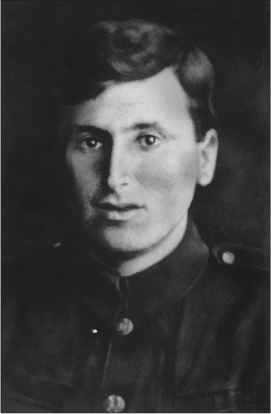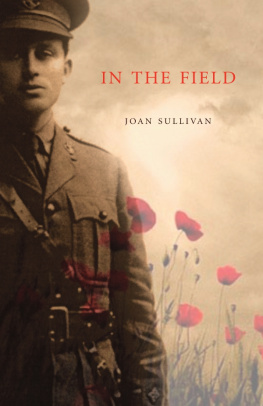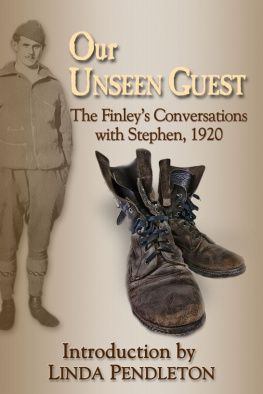
IN THE FIELD
IN THE FIELD
JOAN SULLIVAN


P.O. Box 2188, St. Johns, NL, Canada, A1C 6E6
WWW.BREAKWATERBOOKS.COM
Copyright 2012 Joan Sullivan
LIBRARY AND ARCHIVES CANADA CATALOGUING IN PUBLICATION
Sullivan, Joan, 1963
In the field / Joan Sullivan.
Includes bibliographical references.
ISBN 978-1-55081-391-3
1. Norris, Stephen--Influence. 2.World War, 1914-1918--Casualties-
Newfoundland and Labrador--Three Arms. 3.World War, 1914-1918-
Social aspects--Newfoundland and Labrador--Three Arms.
4. Three Arms (N.L.)--History. I. Title.
FC2195.T57S85 2012 971.8 C2012-904976-X
All Rights Reserved. No part of this publication may be reproduced, stored in a retrieval system or transmitted, in any form or by any means, without the prior written consent of the publisher or a licence from The Canadian Copyright Licensing Agency (Access Copyright). For an Access Copyright licence, visit www.accesscopyright.ca or call toll free to 1-800-893-5777.
Breakwater Books acknowledges the support of the Canada Council for the Arts, which last year invested $154 million to bring the arts to Canadians throughout the country.We acknowledge the Government of Canada through the Canada Book Fund and the Government of Newfoundland and Labrador through the Department of Tourism, Culture and Recreation for our publishing activities.
PRINTED AND BOUND IN CANADA.


CORPORAL WILLIAM SULLIVAN
DEDICATION
For Corporal William Sullivan,
Regiment # 2311, of Kings Cove, Trinity Bay
February 22, 1893 April 28, 1978

SULLIVAN joined the Newfoundland Regiment on March 24, 1916. On August 28, he sailed on the SS Sicilian; on December 1, he was at Rouen, in Northern France; by December 12, he was with the First Battalion. On March 3, 1917, he was wounded at Sailly-Sallisel, invalided to 3rd London General in Wandsworth, England, and then sent to Ayr where the 2nd Battalion was forming. He was sent back to the British Expeditionary Force on February 8, 1918, rejoining them on the 20th as they faced attack in Flanders and the Somme. He was wounded a second time eight days later, hospitalized again, and back in the field October 13.
SULLIVAN was demobbed in St. Johns April 23, 1919, his papers attesting his accounts correctly balanced, his certification that he was in a position to resume civilian occupation immediately, his days in Military service numbering 1126, and his time at the front served in France, Belgium, Germany.
Contents
Reportedly, the death of Stephen Norris in World War I left the Three Arms business without an heir apparent the firm and the Norris family left the village after the death of James Norris in 1924.
from The Encyclopedia of Newfoundland and Labrador

IT is a myth that Stephen Norris was the last surviving son. In fact, Stephen Norris was survived by three brothers, although none worked on Three Arms Island as they were busy with family business concerns elsewhere. But the idea that the loss of Stephen Norris left his family and his community bereft and heirless and, ultimately, extinguished took root and spread.
But that was not the whole story.
And that was not the end of the story.
The Encyclopedia of Newfoundland and Labrador, (St. Johns: Harry Cuff Publications Ltd., 1994), 379.
This and other information on Stephen Norris from an interview with and archival material provided by Bert Riggs, archivist with Memorial Universitys Archives and Special Collections, QEII Library. Any errors are the authors.
There blows a cold norwester

TWO months after the initial fighting at Beaumont Hamel fell into dead silence, a new and different note sounded in the field. It was September 1916; Stephen Norris and the rest of the Regiment were at the Ypres Salient in Belgium, and D Company was hosting a party for the officers. And someone was playing...the accordion. Someone was playing...The Banks of Newfoundland.
...and as the music came from the instrument the sandbagged walls of our H. Q. seemed to fade. The Banks of Newfoundland rang in our ears, and we saw once more the tented slopes of Quidi Vidi on Regatta Day.
The rain fell, and the shells. Harsh chill whispers, portent whistles. But the notes played and played. So far from home, from Newfoundland, they played and played.
Officers description, Reveille, Newfoundland Quarterly 104.1 (2011), 61.
PART ONE

1892.
A leap year.
Ellis Island opens. Lizzie Bordens father and stepmother are found murdered in their home in Fall River, Massachusetts. Sir Arthur Conan Doyle publishes The Adventures of Sherlock Holmes. The Nutcracker, with music by Tchaikovsky, debuts in St. Petersburg. Grover Cleveland is elected President of the United States, and William Gladstone begins his fourth and final term as British Prime Minister. James Naismith introduces the rules of basketball, and Sir Frederick Stanley donates the Stanley Cup to Canadian hockey. Poet Walt Whitman and the coward Robert Ford die. Mary Pickford, J. R. R. Tolkien, and Haile Selassie are born.
In Newfoundland, almost all the commercial, domestic, and ecclesiastical architecture in St. Johns is razed by The Great Fire, of July 8, with $13,000,000 in damages, 11,000 left homeless, but, astonishingly, only three lives lost. That same year, Sir William Whiteway is elected Prime Minister for the second time, retaining Liberal Party rule. Twenty-four landsmen sealers die in Trinity Bay, and Confederation negotiations between the self-governing colony and Canadian Prime Minister, Sir John Thompson, almost come to fruitionan event for celebration or consternation, depending on your politics. And, throughout the city and in the outports of the harbours and bays all over Newfoundland, Stephen Norris and the other infants who will become the soldiers of WWI take their first breaths.

THREE Arms Island is in northern Notre Dame Bay. Its length and width span a few miles. Schooners visited the island for fishing, and when people began staying permanently, they built their stages, flakes, and wharves on the beach running along the islands eastern side. Only a slender seawater channel, a tickle, divided the island from the shore.
The first settlers were two brothers, John and William Wells, and their families. The Wellses were from Twillingate and, before that, from Ringwood, England, which they left in 1792. They were followed by the Strongs (also of Ringwood) and various Coopers, Burts, Vincents, Batstones, Rowsells, and Bartletts, all English or descended from English settlers. Solomon Strong married Jane Wells, and John Wells in turn married Solomons sister. The census of 1845 lists 29 people, all working in the fishery.
Next page


















